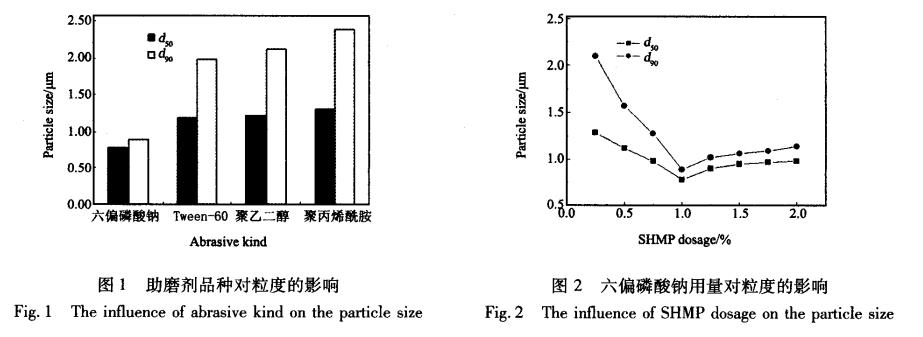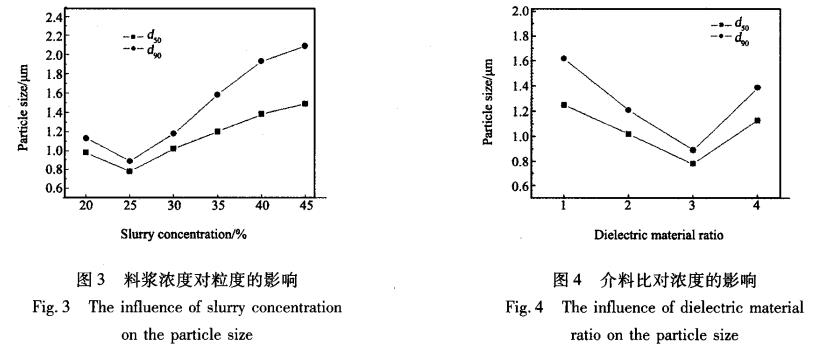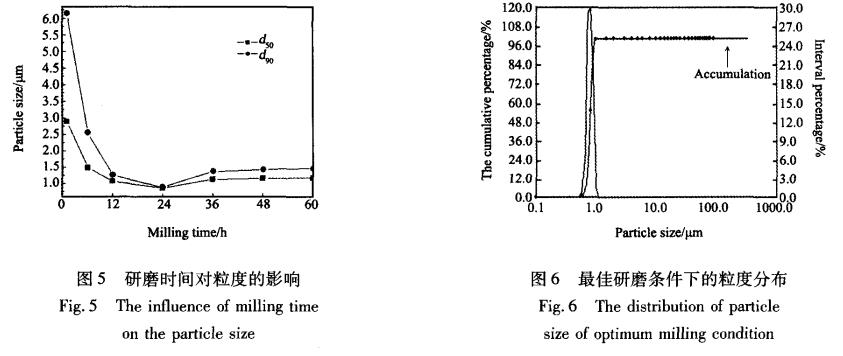Cobalt blue pigment is crucial in various applications, and achieving ultrafine grinding is a critical step in its production. This study investigates wet ball milling for cobalt blue pigment, focusing on factors influencing grinding efficiency: grinding aids, material-to-media ratio, slurry concentration, and milling time. Results show that under specific conditions, including 1.0% sodium hexametaphosphate, a 3:1 material-to-media ratio, 25% slurry concentration, and 24 hours of milling, ultrafine cobalt blue powder with d50=0.78μm and uniform particle distribution is attainable.
IntroductionUltrafine powder production through physical methods involves mechanical comminution, playing a vital role in many industries. Cobalt blue pigment, known for its exceptional properties, is widely used in high-temperature coatings, ceramics, enamel, glass, plastics, and artistic pigments. The primary goal of pigment grinding is to increase the surface area of pigment particles to enhance their coloring properties. This study focuses on wet ball milling to achieve ultrafine cobalt blue pigment and identifies optimal grinding conditions.
Experimental
2.1 Materials and ReagentsCobalt blue powder, produced in-house through high-temperature calcination, was used. The grinding aids employed included sodium hexametaphosphate, Tween-60, polyethylene glycol (molecular weight 20,000), and polyacrylamide.

2.2 Instruments and EquipmentA horizontal ball mill was used for wet ball milling, with zirconia beads (0.5-4.0 mm) as grinding media. Particle size analysis was performed using a BT-9300H laser particle size distribution analyzer.
2.3 Experimental ProcedureCobalt blue powder, deionized water, zirconia beads, and grinding aids were mixed in predetermined proportions in the ball mill tank. Samples were collected after specific milling durations for particle size analysis.
Results and Discussion
3.1 Types of Grinding AidsThe selection and quantity of grinding aids significantly impact grinding efficiency. Two primary theories regarding grinding aid mechanisms exist: (1) "adsorption and hardness reduction" theory posits that grinding aids adsorb onto particles, reducing surface energy, and introducing lattice defects, diminishing particle strength and hardness, and promoting crack propagation; (2) "rheological regulation of slurry" theory suggests that grinding aids modify slurry rheological properties and surface electrical properties, reducing slurry viscosity, promoting particle dispersion, and enhancing slurry flowability. A 25% slurry concentration was maintained, with grinding aid dosage at 1.0% relative to cobalt blue powder mass. Using a 3:1 material-to-media ratio and milling for 24 hours, Figure 1 summarizes experimental results.Figure 1 demonstrates that the grinding aid effectiveness follows this order: polyacrylamide < polyethylene glycol < Tween-60 < sodium hexametaphosphate. Sodium hexametaphosphate exhibits superior performance due to its molecular structure. Sodium hexametaphosphate readily ionizes in aqueous solutions, with resulting anions carrying numerous negative charges. These negatively charged species adsorb onto cobalt blue surfaces, increasing their negative zeta potential and enhancing electrostatic repulsion. Additionally, the repulsion between large molecules increases repulsive forces between cobalt blue particles, leading to effective particle dispersion and optimal grinding efficiency.

3.2 Amounts of Grinding AidsThe quantity of grinding aids significantly affects grinding efficiency. Inadequate dosage fails to achieve optimal grinding efficiency, while excessive dosage increases costs without delivering superior results. With a 3:1 material-to-media ratio and a 25% slurry concentration, different sodium hexametaphosphate dosages (0.50%, 0.75%, 1.00%, 1.25%, 1.50%, 1.75%, and 2.00% relative to cobalt blue powder mass) were investigated after 24 hours of milling, as shown in Figure 2. Figure 2 illustrates that optimal grinding efficiency is achieved when 1.0% sodium hexametaphosphate is added. Deviating from this dosage results in coarser final particle sizes. This indicates that 1.0% sodium hexametaphosphate is the optimal dosage for efficient milling.
3.3 Slurry ConcentrationSlurry concentration directly impacts slurry rheology during ultrafine grinding. High slurry concentration results in poor rheological properties, reduced grinding efficiency, and low shear forces, while low slurry concentration leads to insufficient shear forces and unfavorable grinding effects. Maintaining the appropriate slurry concentration is crucial. Using 1.0% sodium hexametaphosphate as the grinding aid, a 3:1 material-to-media ratio, and varying slurry concentrations (20%, 25%, 30%, 35%, 40%, and 45%), samples were collected after 24 hours of milling for particle size analysis. Experimental results are summarized in Figure 3.Figure 3 shows that a 25% slurry concentration yields the finest particle size. A concentration of 25% significantly influences grinding efficiency, resulting in excessive slurry viscosity, diminished shear forces, poor grinding efficiency, and reduced production efficiency. Slurry concentrations above 25% lead to overly dense slurries, particle clustering, poor dispersion, reduced slurry flowability, and hindered ultrafine grinding.
3.4 Material-to-Media RatioThe material-to-media ratio directly affects grinding efficiency and product particle size during ultrafine grinding. Maintaining a slurry concentration of 25% and using 1.0% sodium hexametaphosphate as the grinding aid, material-to-media ratios of 1:1, 2:1, 3:1, and 4:1 were investigated after 24 hours of milling, as shown in Figure 4.Figure 4 illustrates that a material-to-media ratio of 1:1 yields relatively larger particle sizes due to reduced collision frequency and intensity between grinding media and material. Lower material-to-media ratios result in poorer grinding efficiency. As the material-to-media ratio increases, the frequency of collisions between grinding media and material rises, delivering greater impact energy to the particles and, consequently, smaller particle sizes. However, when the material-to-media ratio exceeds 3:1, particle size increases again due to excessive grinding media that restricts free movement and diminishes impact efficiency.

3.5 Impact of Milling TimeExtending milling time leads to smaller particle sizes, increased specific surface area, surface energy, and particle aggregation tendencies in ultrafine powder processing. After a certain milling time, ultrafine particles reach a dynamic equilibrium between comminution and aggregation, and particle size reduction slows down. In some cases, particle size may even appear to coarsen due to "reverse grinding," causing particle agglomeration. Cobalt blue powder reached its minimum particle size after 24 hours of ultrafine grinding, as shown in Figure 5. Figure 5 displays particle size distribution after different milling durations with 1.0% sodium hexametaphosphate, a 3:1 material-to-media ratio, 25% slurry concentration, and samples collected at 6, 12, 24, 36, 48, and 60 hours.Figure 5 demonstrates that particle fineness of cobalt blue powder decreases with increasing milling time from 6 to 24 hours. However, after 24 hours of milling, the particle size of the powder remains largely unchanged, or it may even coarsen due to "reverse grinding" and particle agglomeration. This indicates that cobalt blue powder reached its minimum particle size after 24 hours of ultrafine grinding. Figure 6 illustrates the particle size distribution of cobalt blue pigment after 24 hours of milling under optimal conditions, with 1.0% sodium hexametaphosphate, a slurry concentration of 25%, and a material-to-media ratio of 3:1. It reveals that under these ideal conditions, ultrafine cobalt blue pigment with d50=0.78μm and d90=0.89μm and a uniform particle size distribution can be obtained.

Conclusion
(1) Different grinding aids exhibit varying levels of effectiveness. Among the grinding aids used in this study, sodium hexametaphosphate demonstrated superior grinding efficiency, with an optimal dosage of 1.0% relative to the cobalt blue powder mass.(2) Slurry concentration and material-to-media ratio significantly impact ultrafine grinding. In this study, using a slurry concentration of 25%, a material-to-media ratio of 3:1, and adding 1.0% sodium hexametaphosphate, milling for 24 hours resulted in ultrafine cobalt blue pigment with particle sizes of d50=0.78μm and d90=0.89μm and a uniform particle size distribution.

Submit your demand,
we will contact you ASAP.

Sanxin New Materials Co., Ltd. focus on producing and selling ceramic beads and parts such as grinding media, blasting beads, bearing ball, structure part, ceramic wear-resistant liners, Nanoparticles Nano Powder

